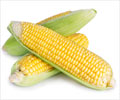Sustainable biofuel could be obtained by introducing a maize (corn) gene into switchgrass, a highly valued potential feedstock for advanced biofuels,

The plant offers a number of advantages. As a perennial grass that is both salt- and drought-tolerant, switchgrass can flourish on marginal cropland, does not compete with food crops, and requires little fertilization. A key to its use in biofuels is making it more digestible to fermentation microbes.
But unlike the starch sugars in grains, the complex polysaccharides in the cellulose of plant cell walls are locked within a tough woody material called lignin. For advanced biofuels to be economically competitive, scientists must find inexpensive ways to release these polysaccharides from their bindings and reduce them to fermentable sugars that can be synthesized into fuels.
Now an important step towards achieving this goal has been taken by researchers with the U.S. Department of Energy (DOE)’s Joint BioEnergy Institute (JBEI), a DOE Bioenergy Research Center led by the Lawrence Berkeley National Laboratory (Berkeley Lab).
A team of JBEI researchers, working with researchers at the U.S. Department of Agriculture’s Agricultural Research Service (ARS), has demonstrated that introducing a maize (corn) gene into switchgrass more than doubles (250 percent) the amount of starch in the plant’s cell walls and makes it much easier to extract polysaccharides and convert them into fermentable sugars. The gene, a variant of the maize gene known as Corngrass1 (Cg1), holds the switchgrass in the juvenile phase of development, preventing it from advancing to the adult phase.
“We show that Cg1 switchgrass biomass is easier for enzymes to break down and also releases more glucose during saccharification,” says Blake Simmons, a chemical engineer who heads JBEI’s Deconstruction Division and was one of the principal investigators for this research. “Cg1 switchgrass contains decreased amounts of lignin and increased levels of glucose and other sugars compared with wild switchgrass, which enhances the plant’s potential as a feedstock for advanced biofuels.”
Advertisement
But there are questions to be answered. For example, the Cg1 switchgrass biomass still required a pre-treatment to efficiently liberate fermentable sugars.
Advertisement
Another question to be answered pertains to the mechanism by which Cg1 is able to keep switchgrass and other plants in the juvenile phase.
George Chuck, lead author of the PNAS paper and a plant molecular geneticist, points out, “We know that Cg1 is controlling an entire family of transcription factor genes, but we have no idea how these genes function in the context of plant aging. It will probably take a few years to figure this out.”
Source-Medindia








